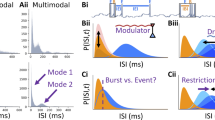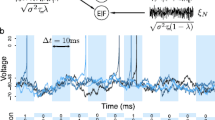Abstract
Multiple methods have been developed in an attempt to quantify stimulus-induced neural coordination and to understand internal coordination of neuronal responses by examining the synchronization phenomena in neural discharge patterns. In this work we propose a novel approach to estimate the degree of concomitant firing between two neural units, based on a modified form of mutual information (MI) applied to a two-state representation of the firing activity. The binary profile of each single unit unfolds its discharge activity in time by decomposition into the state of neural quiescence/low activity and state of moderate firing/bursting. Then, the MI computed between the two binary streams is normalized by their minimum entropy and is taken as positive or negative depending on the prevalence of identical or opposite concomitant states. The resulting measure, denoted as Concurrent Firing Index based on MI (CFIMI), relies on a single input parameter and is otherwise assumption-free and symmetric. Exhaustive validation was carried out through controlled experiments in three simulation scenarios, showing that CFIMI is independent on firing rate and recording duration, and is sensitive to correlated and anti-correlated firing patterns. Its ability to detect non-correlated activity was assessed using ad-hoc surrogate data. Moreover, the evaluation of CFIMI on experimental recordings of spiking activity in retinal ganglion cells brought insights into the changes of neural synchrony over time. The proposed measure offers a novel perspective on the estimation of neural synchrony, providing information on the co-occurrence of firing states in the two analyzed trains over longer temporal scales compared to existing measures.








Similar content being viewed by others
References
Allen, A.E., Storchi, R., Martial, F.P., Bedford, R.A., & Lucas, R.J. (2017). Melanopsin contributions to the representation of images in the early visual system. Current Biology, 27(11), 1623–1632.
Brivanlou, I.H., Warland, D.K., & Meister, M. (1998). Mechanisms of concerted firing among retinal ganglion cells. Neuron, 20(3), 527–539.
Brown, E.N., Kass, R.E., & Mitra, P.P. (2004). Multiple neural spike train data analysis: state-of-the-art and future challenges. Nature Neuroscience, 7(5), 456–461.
Brown, T.M., Gias, C., Hatori, M., Keding, S.R., Semo, M., Coffey, P.J., Gigg, J., Piggins, H.D., Panda, S., & Lucas, R.J. (2010). Melanopsin contributions to irradiance coding in the thalamo-cortical visual system. PLoS Biology 8(12).
Buzsaki, G. (2006). Rhythms of the Brain. Oxford: Oxford University Press.
Cutts, C.S., & Eglen, S.J. (2014). Detecting pairwise correlations in spike trains: an objective comparison of methods and application to the study of retinal waves. Journal of Neuroscience, 34(43), 14288–14303.
Daw, C.S., Finney, C.E.A., & Tracy, E.R. (2003). A review of symbolic analysis of experimental data. Review of Scientific Instruments, 74(2), 915–930.
Eggermont, J.J. (2010). Pair-correlation in the time and frequency domain. In Analysis of parallel spike trains (pp. 77–102): Springer,.
Ermentrout, G.B., Galán, R F, & Urban, N.N. (2008). Reliability, synchrony and noise. Trends in Neurosciences, 31(8), 428–434.
Fred, A.L., & Leitão, J.M. (2003). A new cluster isolation criterion based on dissimilarity increments. IEEE Transactions on Pattern Analysis and Machine Intelligence, 25(8), 944–958.
Gollisch, T., & Meister, M. (2008). Rapid neural coding in the retina with relative spike latencies. Science, 319(5866), 1108–1111.
Gray, R.M. (2011). Entropy and information theory. Berlin: Springer Science & Business Media.
Gray, R.M., & Shields, P.C. (1977). The maximum mutual information between two random processes. Information and Control, 33(4), 273–280.
Grewe, J., Kruscha, A., Lindner, B., & Benda, J. (2017). Synchronous spikes are necessary but not sufficient for a synchrony code in populations of spiking neurons. Proceedings of the National Academy of Sciences, 114(10), E1977–E1985.
Guzzetti, S., Borroni, E.A., Garbelli, P.E., Ceriani, E., Della Bella, P., Montano, N., Cogliati, C., Somers, V.K., Malliani, A., & Porta, A. (2005). Symbolic dynamics of heart rate variability - a probe to investigate cardiac autonomic modulation. Circulation, 112(4), 465–470.
Ishikane, H., Gangi, M., Honda, S., & Tachibana, M. (2005). Synchronized retinal oscillations encode essential information for escape behavior in frogs. Nature Neuroscience, 8(8), 1087–1095.
Izhikevich, E.M. (2003). Simple model of spiking neurons. IEEE Transactions on Neural Networks, 14(6), 1569–1572.
Izhikevich, E.M. (2007). Dynamical systems in neuroscience. Cambridge: MIT press.
Kandel, E.R., Schwartz, J.H., Jessell, T.M., Biochemistry, D., Jessell, M.B.T., Siegelbaum, S., & Hudspeth, A. (2000). Principles of neural science Vol. 4. New York: McGraw-hill.
Kerschensteiner, D., & Wong, R.O. (2008). A precisely timed asynchronous pattern of on and off retinal ganglion cell activity during propagation of retinal waves. Neuron, 58(6), 851– 858.
Kreuz, T., Mulansky, M., & Bozanic, N. (2015). Spiky: a graphical user interface for monitoring spike train synchrony. Journal of Neurophysiology, 113(9), 3432–3445.
Li, W. (1990). Mutual information functions versus correlation functions. Journal of Statistical Physics, 60(5-6), 823–837.
Meister, M., Lagnado, L., & Baylor, D.A. (1995). Concerted signaling by retinal ganglion cells. Science, 270(5239), 1207–1210.
Mijatović, G, Lončar-Turukalo, T., Procyk, E., & Bajić, D. (2018). A novel approach to probabilistic characterisation of neural firing patterns. Journal of Neuroscience Methods, 305, 67–81.
Mijatovic, G., Loncar-Turukalo, T., Bozanic, N., & Faes, L. (2020). Information–theoretic characterization of concurrent activity of neural spike trains. In 2020 28th european signal processing conference (pp. 925–929). EUSIPCO: IEEE.
Milosavljevic, N., Storchi, R., Eleftheriou, C.G., Colins, A., Petersen, R.S., & Lucas, R.J. (2018). Photoreceptive retinal ganglion cells control the information rate of the optic nerve. Proceedings of the National Academy of Sciences, 115(50), E11817– E11826.
Niebur, E. (2007). Generation of synthetic spike trains with defined pairwise correlations. Neural Computation, 19(7), 1720–1738.
Ostojic, S. (2011). Interspike interval distributions of spiking neurons driven by fluctuating inputs. Journal of Neurophysiology, 106(1), 361–373.
Pasquale, V., Massobrio, P., Bologna, L., Chiappalone, M., & Martinoia, S. (2008). Self-organization and neuronal avalanches in networks of dissociated cortical neurons. Neuroscience, 153(4), 1354– 1369.
Porta, A., Baumert, M., Cysarz, D., & Wessel. N. (2015). Enhancing dynamical signatures of complex systems through symbolic computation.
Puchalla, J.L., Schneidman, E., Harris, R.A., & Berry, M.J. (2005). Redundancy in the population code of the retina. Neuron, 46(3), 493–504.
Ricci, L., Castelluzzo, M., Minati, L., & Perinelli, A. (2019). Generation of surrogate event sequences via joint distribution of successive inter-event intervals. Chaos: An Interdisciplinary Journal of Nonlinear Science, 29(12), 121102.
Schlather, M., Ribeiro, P.J. Jr, & Diggle, P.J. (2004). Detecting dependence between marks and locations of marked point processes. Journal of the Royal Statistical Society: Series B (Statistical Methodology), 66 (1), 79–93.
Schneidman, E., Bialek, W., & Berry, M.J. (2003). Synergy, redundancy, and independence in population codes. Journal of Neuroscience, 23(37), 11539–11553.
Schneidman, E., Berry, M.J., Segev, R., & Bialek, W. (2006). Weak pairwise correlations imply strongly correlated network states in a neural population. Nature, 440(7087), 1007–1012.
Schnitzer, M.J., & Meister, M. (2003). Multineuronal firing patterns in the signal from eye to brain. Neuron, 37(3), 499– 511.
Shannon, C.E. (1948). A mathematical theory of communication. Bell System Technical Journal, 27(3), 379–423.
Shlens, J., Field, G.D., Gauthier, J.L., Grivich, M.I., Petrusca, D., Sher, A., Litke, A.M., & Chichilnisky, E. (2006). The structure of multi-neuron firing patterns in primate retina. Journal of Neuroscience, 26(32), 8254–8266.
Shlens, J., Rieke, F., & Chichilnisky, E. (2008). Synchronized firing in the retina. Current Opinion in Neurobiology, 18(4), 396– 402.
Singer, W. (1999). Neuronal synchrony: A versatile code for the definition of relations?. Neuron, 24(1), 49–65.
Spavieri, D.L., Eichner, H., & Borst, A. (2010). Coding efficiency of fly motion processing is set by firing rate, not firing precision. PLoS Computational Biology, 6(7), e1000860.
Steuer, R., Ebeling, W., Russell, D., Bahar, S., Neiman, A., & Moss, F. (2001). Entropy and local uncertainty of data from sensory neurons. Physical Review E, 64(6), 061911.
Usher, M., & Donnelly, N. (1998). Visual synchrony affects binding and segmentation in perception. Nature, 394(6689), 179–182.
Usrey, W.M., & Reid, R.C. (1999). Synchronous activity in the visual system. Annual Review of Physiology, 61(1), 435–456.
Wong, K.Y. (2012). A retinal ganglion cell that can signal irradiance continuously for 10 hours. Journal of Neuroscience, 32(33), 11478–11485.
Wong, R.O., Meister, M., & Shatz, C.J. (1993). Transient period of correlated bursting activity during development of the mammalian retina. Neuron, 11(5), 923–938.
Hp, X u, Furman, M., Mineur, Y.S., Chen, H., King, S.L., Zenisek, D., Zhou, Z.J., Butts, D.A., Tian, N., Picciotto, M.R., & et al. (2011). An instructive role for patterned spontaneous retinal activity in mouse visual map development. Neuron, 70(6), 1115–1127.
Acknowledgments
This research has been supported by the Ministry of Education, Science and Technological Development through the project no. 451-03-68/2020-14/200156: “Innovative scientific and artistic research from the FTS (activity) domain” and from the European Union’s Horizon 2020 research and innovation programme under Grant Agreement number 856967. Luca Faes acknowledges funding from Ministero dell’Istruzione, dell’Università e della Ricerca—PRIN 2017 (PRJ-0167), “Stochastic forecasting in complex systems”. The authors express gratitude to Leonardo Ricci and Alessio Perinelli for sharing Matlab code for JODI method, and to Danica Despotovic for useful discussion.
Author information
Authors and Affiliations
Corresponding author
Ethics declarations
Conflict of Interests
The authors declare that they have no conflict of interest.
Additional information
Publisher’s Note
Springer Nature remains neutral with regard to jurisdictional claims in published maps and institutional affiliations.
Rights and permissions
About this article
Cite this article
Mijatovic, G., Loncar-Turukalo, T., Bozanic, N. et al. A Measure of Concurrent Neural Firing Activity Based on Mutual Information. Neuroinform 19, 719–735 (2021). https://doi.org/10.1007/s12021-021-09515-w
Accepted:
Published:
Issue Date:
DOI: https://doi.org/10.1007/s12021-021-09515-w




